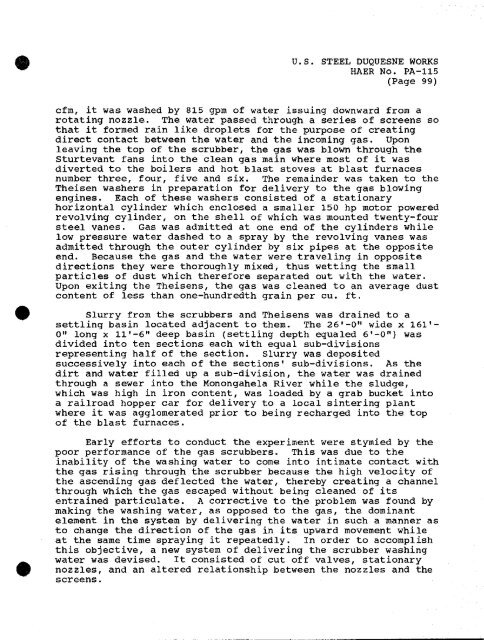pa1778data.pdf
pa1778data.pdf
pa1778data.pdf
You also want an ePaper? Increase the reach of your titles
YUMPU automatically turns print PDFs into web optimized ePapers that Google loves.
U.S. STEEL DUQUESNE WORKS<br />
HAER No. PA-115<br />
(Page 99)<br />
cfm, it was washed by 815 gpm of water issuing downward from a<br />
rotating nozzle. The water passed through a series of screens so<br />
that it formed rain like droplets for the purpose of creating<br />
direct contact between the water and the incoming gas. Upon<br />
leaving the top of the scrubber, the gas was blown through the<br />
Sturtevant fans into the clean gas main where most of it was<br />
diverted to the boilers and hot blast stoves at blast furnaces<br />
number three, four, five and six. The remainder was taken to the<br />
Theisen washers in preparation for delivery to the gas blowing<br />
engines. Each of these washers consisted of a stationary<br />
horizontal cylinder which enclosed a smaller 150 hp motor powered<br />
revolving cylinder, on the shell of which was mounted twenty-four<br />
steel vanes. Gas was admitted at one end of the cylinders while<br />
low pressure water dashed to a spray by the revolving vanes was<br />
admitted through the outer cylinder by six pipes at the opposite<br />
end. Because the gas and the water were traveling in opposite<br />
directions they were thoroughly mixed, thus wetting the small<br />
particles of dust which therefore separated out with the water.<br />
Upon exiting the Theisens, the gas was cleaned to an average dust<br />
content of less than one-hundredth grain per cu. ft.<br />
^P Slurry from the scrubbers and Theisens was drained to a<br />
settling basin located adjacent to them. The 26'-0" wide x 161'-<br />
0" long x ll'-6" deep basin (settling depth equaled 6'-0") was<br />
divided into ten sections each with equal sub-divisions<br />
representing half of the section. Slurry was deposited<br />
successively into each of the sections* sub-divisions. As the<br />
dirt and water filled up a sub-division, the water was drained<br />
through a sewer into the Monongahela River while the sludge,<br />
which was high in iron content, was loaded by a grab bucket into<br />
a railroad hopper car for delivery to a local sintering plant<br />
where it was agglomerated prior to being recharged into the top<br />
of the blast furnaces.<br />
Early efforts to conduct the experiment were stymied by the<br />
poor performance of the gas scrubbers. This was due to the<br />
inability of the washing water to come into intimate contact with<br />
the gas rising through the scrubber because the high velocity of<br />
the ascending gas deflected the water, thereby creating a channel<br />
through which the gas escaped without being cleaned of its<br />
entrained particulate. A corrective to the problem was found by<br />
making the washing water, as opposed to the gas, the dominant<br />
element in the system by delivering the water in such a manner as<br />
to change the direction of the gas in its upward movement while<br />
at the same time spraying it repeatedly. In order to accomplish<br />
this objective, a new system of delivering the scrubber washing<br />
# water was devised. It consisted of cut off valves, stationary<br />
nozzles, and an altered relationship between the nozzles and the<br />
screens.

















